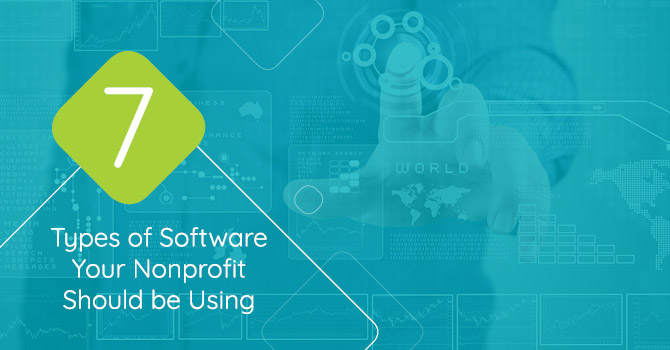-
Software
Compliance Software
Oversee licenses, track renewals, access documents, and more from a single interface.
Software Overview -
Services
Compliance Services
Full service compliance solutions for organizations throughout their entire lifecycles.
Services Overview -
Industries
-
Partner
- Information Center
7 Types of Software Your Nonprofit Should be Using

Nonprofit software may not be what drives your organization — that’s your mission. It’s not even what makes it possible to pursue that mission — that’s your staff. Instead, nonprofit software serves the crucial function of smoothing the pathway to accomplish your goals and grow so that your impact can be even greater.
Think about it: you have the ability to send out individual emails to each of your supporters asking for additional donations. But that would take a lot of (if not all of) a staff member’s time to do so. Meanwhile, a marketing tool can accomplish the same task in just minutes, creating a more efficient process.
While this is a simple example, the concept rings true for all effective nonprofit software. These solutions are designed to help your organization accomplish more, grow faster, and impact more people.
When your nonprofit invests in software, keep in mind that new tools need to check off a few essential boxes. Your software should fill a specific need or gap in your processes; remain compliant with national, state, and agency requirements, and fit into your organization’s budget.
The software that your organization should begin researching for potential investment (or reinvestment if you’re conducting a tech overhaul) include:
- Fund Accounting Software
- CRM Software
- Fundraising Tools
- Prospect Research Database
- Matching Gift Database
- Website Builder
- 990 e-Filer
We’ll dive a little deeper into each of these solutions and explain how they fit into the greater nonprofit software ecosystem. Let’s get started.

1. Accounting software
A nonprofits’ focus is on accountability rather than profitability, with the need to manage multiple funding sources that have restrictions or unique reporting requirements. This requires a system that handles more than what a single-fund accounting software can provide.
Look for fund accounting software specifically tailored to help with the intricacies of bookkeeping for nonprofits. Organization-specific software will better adhere to the individual needs of your nonprofit.
For instance, look for software that supports:
- Multi-dimensional chart of accounts
- A clear audit trail and fraud protection
- Built-in FASB-compliant reports
- Integrations with fundraising, CRM, and other tech (we’ll discuss more on that later)
If you’re in a hurry to learn about more tools your organization should look for in accounting software, check out this resource from MIP Fund Accounting.
The main reason why fund accounting software is a must-have for your toolkit, though, is that it organizes the generously provided finances that help you achieve your mission.
While we all wish we could reach our nonprofit goals without money, most of them require funding to get there. And organization of that money will help your budget responsively and prioritize as necessary to grow your nonprofit and continue making an impact.
Of course, when you invest in your fund accounting software solution, remember to craft your budget for investments in the other solutions you need.

2. CRM (constituent relationship management) tools
Your nonprofit’s CRM solution is the heart of data regarding your support base. This is where you store information with a supporter’s name, demographic data, contact information, business connections, donation history, giving preferences, events attended, volunteer history, and just about anything else you can think of.
Double the Donation’s nonprofit CRM guide defines this software as, “a way for nonprofits to track their relationships with donors and other constituents.” Tracking this information provides insights to help nonprofits tailor their outreach strategies, build relationships, and raise more money.
Look for CRM software that integrates with the other solutions in which you’ll invest. As the central hub of information, integrations with your CRM are especially important because they streamline the recording and storing of data. This minimizes manual input which often leads to human error.

3. Fundraising software
Your nonprofit runs on donations. These generous contributions are how you acquire the funding you need to pursue your mission. Therefore, any software that can help you streamline this process and bring in donations will ultimately help your nonprofit grow.
Online fundraising software includes the tools you need to accomplish various campaigns. For instance, your organization should look into software for:
- Online donation pages
- Peer-to-peer fundraising
- Pledge fundraising
- Text-to-give
- Crowdfunding
Along with these important sources for fundraising campaigns, your nonprofit should look for fundraising software that enables communication with clients in order to make an ask. This could be included in the fundraising software, CRM, etc.
Then, look for integrations with your fund accounting solution. These integrations will ensure all of your fundraising data is recorded in your system in order for you to create the best budget with such funds.

4. Prospect research database
One of the keys to securing the largest potential gifts from your supporters is prospect research software. These tools allow your organization to search an extensive external database for more information about the wealth and philanthropic habits of your donors.
With access to this important information, your nonprofit can gain insight as to which donors in your database will make the best major gift prospects.
Specifically, prospect research databases should provide further context about:
- Philanthropic indicators. Philanthropic indicators are those that show a donor’s affinity for giving to your organization based on their involvement with other nonprofits, philanthropic history, and interests. An emerging way to learn more about these indicators is through social discovery, or the research completed using a prospect’s social media accounts. You can learn more about this trend by clicking here.
- Wealth indicators. Wealth indicators provide information about how much a donor could give to your nonprofit. Wealth indicators rely on key information such as a donor’s real estate holdings, stock ownership, business affiliations, and more. These can help your nonprofit ask for just the right amount from potential major donors.
Prospect research can help your organization make informed decisions and communications when you’re cultivating relationships with potential major donors. Don’t forget about your mid-tier donors too, though! These are the constituents who you can steward to become major donors in the future.

5. Matching gift software
Matching gift software helps take your nonprofit’s fundraising to the next level. Many corporate social responsibility programs will match the donations that their employees make to qualifying nonprofits.
However, most donors don’t know that such programs are available to them, so a ton of money goes left on the table unclaimed each year. Matching gift software is designed to inform supporters of their eligibility for a matched gift.
Your nonprofit, when incorporating matching gifts into your strategy, should:
- Include the matching gift database search tool for donors on the confirmation page.
- Launch an email campaign to inform people about this opportunity.
- Keep records of the gifts that are matched so they don’t get lost in your accounting software.
If you’re looking for an easier way to incorporate these gifts into your strategy, your nonprofit may look into a completely automated matching gift system. These tools can identify matching gift opportunities based on the email domain of donors. Then, you can trigger automatic emails to inform them of their eligibility and link them directly to the matching gift form for their company.

6. Website builder
When it comes to constituent-facing technology, your nonprofit’s website is one of your most important resources. This is where supporters and constituents go to find more information about your mission and how they can get involved.
Access to an easy-to-use web builder helps your nonprofit ensure that the information you present to site visitors is up-to-date and relevant.
Be sure your nonprofit has access to the web design tools that will help make it easier for supporters to find what they need so that you can get more from your web presence. For instance, you should look for:
- Mobile-optimized pages. Make sure your supporters can reach any of your pages no matter what type of device they’re using to access the internet.
- Built-in event pages. Create event registration pages and provide all of the attendance information your supporters need.
- Social media sharing. Be sure your site visitors can share your blog content (or your homepage) on their social media pages to spread the word about your organization.
The most important part of a new website builder is that it helps your nonprofit prepare for the future. Be sure you’re ready for your organization to scale up and that you’ll have access to all of the tools you need now as well as in the future.

7. 990 e-filer
No one likes tax season. Although registered 501(c)(3) organizations don’t need to pay taxes, they still need to file annually for continued tax-exempt status. This is done through the Form 990.
This form requires nonprofits to fill out information about their organization, its annual revenue, and the allocation of that revenue throughout the last year. Before you get started filing, be sure you’re organized with access to information such as:
- Your nonprofit’s EIN
- Tax year
- Legal name and address
- Web address
- Gross receipts
- Expenses
- Assets
- Your mission
- Prior year’s return
- Exemption type
So how does software fit into all of this?
An e-filer helps your organization streamline how these forms are filled out and makes it easier to keep organized. Many tools can pull relevant information directly from the IRS database based on your nonprofit’s EIN to autofill certain parts of the form (like your legal name, web address, tax year, address, etc.)
Then, e-filers make filling out the rest of the form easy by asking your organization straightforward questions about the previous tax year. It’ll then autofill the correct parts of the form for you.
Software is designed to ease the processes of gathering donations, communicating with supporters, and reporting on vital information. Picking the best software for your organization will help you reach new heights towards engaging your community and pursuing your mission. But that’ll take a little bit more research.
Access to valuable tools such as Harbor Compliance’s Information Center or other trusted referral guides will help you make the decisions that will best benefit your nonprofit.

Pia Simeoni is Director of Marketing for Nonprofit Solutions at Community Brands. You can find Pia on LinkedIn and Twitter.





